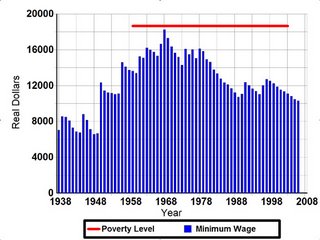http://oregonstate.edu/instruct/anth484/minwage.html
This research, done by Oregon State University, gives a brief overview of the minimum wage in the United States since its incipience. It uses graphs taken from the U.S. Bureau of the Census, U.S. Department of Labour, and the Bureau of Labor Statistics.
It states that Washington has the highest minimum wage in the country at $7.63 as of January 2006, a full $2.48 more than the federal minimum wage, which is going through the longest period of stagnation in the history of the minimum wage.

It seems so odd to me that as many as 28 states can change their laws, and yet the federal government doesn't respond. We talk about the problem of poverty as an issue in this country, yet ignore the fact that one of our federal laws nearly force people to remain below the poverty line. This is shown by charts in the article, which exemplify that minimum wage levels have never been sufficient to raise a family out of poverty. The minimum wage reached its highest point in real 2005 dollars in 1968, when the wage was 1.60 (9.20 adjusted for inflation). Even this wage doesn't reach the poverty level income, and it doesn't even come close in other years.
Through what we have been talking about in class, I get that it can be very difficult to pass a piece of legislation, but I don't see how the wage increased exponentially for so long and has now remained stuck while the economy continues to go forward. More people are falling behind and it seems like this should be at the forefront of policymakers' minds. Having more people below the poverty line will only cause more problems in the end.
